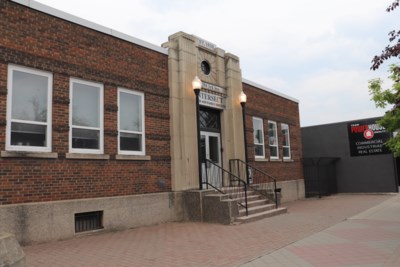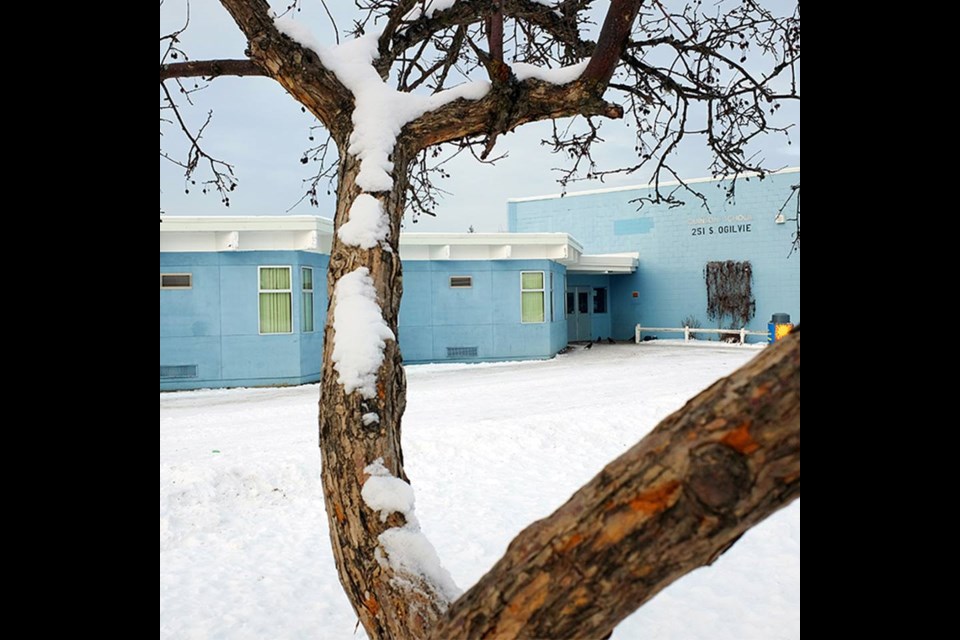Some of these buildings are iconic to Prince George, like the South Fort George School House, while others like the Sixth Avenue Liquor Store (now Bridget Moran Place) are lesser known.
 Sixth Avenue Liquor Store is historically significant for its distinct architectural style. The building’s facade, which was the standard design used for provincial liquor stores built in the '40s and '50s, incorporated elements of the popular 1930s "Moderne" architectural style, often confused with art deco. (via Heritage Commission)
Sixth Avenue Liquor Store is historically significant for its distinct architectural style. The building’s facade, which was the standard design used for provincial liquor stores built in the '40s and '50s, incorporated elements of the popular 1930s "Moderne" architectural style, often confused with art deco. (via Heritage Commission)"I think it’s important for the citizens of Prince George to realize how much history we have in Prince George and how much we can celebrate as well," says Alisha Rubadeau, chair of the Prince George Heritage Commission.
The Heritage Commission works to identify properties and sites in the city that have historical value and encourages their conservation, maintenance and restoration.
Rubadeau became involved with the Heritage Commission two years ago, when she began working for a business improvement association.
"I wanted to sit on the commission and have some say in what was happening and what was being added to the heritage register," she says.
The Heritage Register is an official list of buildings and sites that have heritage value and it’s meant to flag properties so the city can share the historical information with property owners.
Properties on the register are significant either for the time they were built, their architectural style or if they housed someone who was an important figure in the Prince George community.
"I think, for the most part, people walk around (and) they don’t really realize we have some really nice architecturally styled buildings for what years they were built and for what styles they were built," says Rubadeau, adding “it just gives people a sense of pride for being in Prince George and knowing we have a good long history.”
Rubadeau says her favourite building on the register is the Old Post Office on Third Avenue, which is a one-storey, art deco-influenced building from 1939 and was the first permanent location for postal and other government services in Prince George.
 The Federal Government Building, known as the Old Post Office, mixes art deco and modern classical features. Although the building's interior has been modified over time, the exterior remains much the same as it did when the building was first constructed and it remains a lasting symbol of 20th-century federalism in Prince George. (via Hanna Petersen).
The Federal Government Building, known as the Old Post Office, mixes art deco and modern classical features. Although the building's interior has been modified over time, the exterior remains much the same as it did when the building was first constructed and it remains a lasting symbol of 20th-century federalism in Prince George. (via Hanna Petersen)."They did some work to it a year or two before, and they actually uncovered a beautiful window at the top that no one had realized was there at the time," says Rubadeau, adding "another one I really like is the Taylor House. It’s in the Crescents area and it’s just beautiful."
Rubadeau says a few unique sites were added to the register last year: Quinson Elementary School, which was built in the 1960s, was put on the list because of its pentagonal-shaped design which was different from standard classroom design.
They also added the American elm trees on Dogwood, Elm and Vancouver streets to the register.
“The trees themselves are a bit iconic to Prince George and a lot of people go wondering around the Miller Addition because it is beautiful with the trees that canopy over the street,” says Rubadeau.
She explained that there’s also heritage value in the trees because they were planted as part of a federal housing program for returning Second World War veterans.
Rubadeau says they are looking at adding four more properties to the register this year and always welcome new applications for properties that may have historical value.
For a property to make the list, Rubadeau says it needs to be of significance to Prince George.
“It needs to have architectural significance, or a significant builder, or someone that was very significant in the Prince George community,” she says, noting that the process to apply, however, is quite easy.
Anyone interested can fill out an online application, after which the Heritage Commission or someone from the city will follow up on.
To find out more about the Heritage Register and why the buildings and sites were chosen, visit the City of Prince George website for more information on each property.


